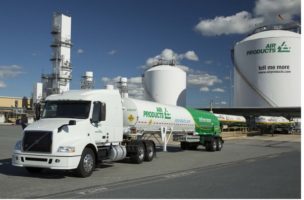
Air Products & Chemicals (APD), is one of the few (51 S&P 500 companies) to make it into the dividend aristocrat club, meaning that it’s been raising its dividend for at least 25 consecutive years.

In fact, since 1983 Air Products has been growing its dividend at an annual rate of 9.6%, which has not only resulted in exponentially growing income for shareholders, but also decades of market-beating total returns (10.5% annual total return vs 8.7% for the S&P 500 over the last 22 years).
However, the key to such consistent success is being able to evolve with changing market and industrial conditions, which in recent years have been rather challenging for APD and resulted in much slower payout growth than in the past.
Let’s take a closer look at what management is doing to not only keep the company’s impressive payout growth streak alive but also turnaround the overall business model to re-accelerate dividend growth.
Business Overview
Founded in 1940 in Allentown, Pennsylvania, Air Products & Chemicals is one of the world’s largest provider of atmospheric gases, process and specialty gases, electronics and performance materials, equipment, and services to a host of large global clients in over 30 industries in more than 50 countries.
Its 17,000 employees operate over 750 manufacturing facilities, as well as 1,800 miles of industrial gas pipelines. Air Products is the world’s largest supplier of hydrogen and helium with approximately 40% market share in those two critical gases.
In other words, APD is one of those classic, boring industrial giants providing things like liquid oxygen, nitrogen, argon, hydrogen, helium, carbon dioxide, carbon monoxide, syngas, and rare gases to companies that use them in the manufacturing of metals, glass, chemical processing, electronics, energy production and refining, food processing, metallurgical, medical, and general manufacturing.

The company is highly diversified geographically, with a strong presence in not just North America and Europe, but also fast-growing emerging markets in Asia and Latin America.

Source: 2016 Annual Report
Note that in 2016 APD decided to discontinue its materials technologies division by selling off certain assets to Evonik Industries AG for $3.8 billion and spinning off the rest of the unit into shares of Versum Materials to shareholders in October 2016. These actions allowed Air Products to focus completely on its industrial gas businesses.
Business Analysis
The key to becoming a dividend aristocrat is to have a highly predictable, stable, growing source of revenue, earnings, and cash flow. Preferably one protected by a wide moat, meaning competitive advantages that allow a company to maintain or grow profitability over time.
When it comes to industrial gases, while the products themselves are entirely commoditized, the manufacturing and distribution processes of them is actually highly complex. For example, a new gas facility can cost $2 billion to $3 billion and take several years to construct, assuming all technical regulations are complied with.
In addition, while the gas itself is usually low cost (air is a very cheap raw material), transporting and storing it is far more complex and expensive (e.g. liquid oxygen put in a tanker will evaporate after 200 miles). That’s because it requires advanced infrastructure such as cryogenic gas storage equipment, large pipeline networks, and vast fleets of specialized tanker trucks.
These substantial costs mean that smaller rivals can’t compete well on price because customers ultimately care more about reliable delivery of gases from sizable distribution networks that only large players can provide.
The high transportation costs also make industrial gas a local business, with competition typically limited to a radius no greater than a couple hundred miles. When combined with Air Products’ long-term contracts and relationships with many customers, new entrants have a hard time taking market share.
Since gas typically accounts for just a small portion of a customer’s total manufacturing costs and is a non-discretionary expense, APD is able to enjoy some pricing power as well.
















